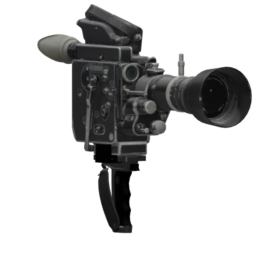Bolex

Bolex Podcast (6:13)
Note: Text in square brackets describes the soundscape as well as certain specific or occasional sounds.
[Ambience of a living room during a surprise party]
Narrator (whispering) : She’s coming! She’s coming!
[We hear a few quick steps as guests get into place and say hush. The door opens and someone enters the room. The narrator and the guests shout “SURPRISE!” The grandmother yells. Her shout is quickly followed by laughter. Everyone applauds]
Narrator: Happy birthday Grandma!
[Theme music begins: soft piano melody]
[The narrator laughs softly]
Narratrice: It worked so well! You should have seen my grandma’s face! Plus, I recorded the whole thing!
[We hear the “SURPRISE!” followed by the grandmother’s scream from the narrator’s cell phone]
Narrator: As a birthday gift for my grandma this year, I made a short film using videos of my family members that I shot on my phone. I discovered a video editing app with lots of options for different music and filters. My favorite filter is the 16mm film one. It makes my videos look vintage!
When my grandma saw my gift, she became nostalgic. She remembered the home movies she used to shoot with a very special camera when she was young: a Bolex H16.
[Sound effect of the Bolex rolling]
My grandmother also had a passion for cameras? So it runs in the family! I had so many questions for her about the Bolex. Could this camera create visual effects? Could she shoot with the same effects that exist on cell phones nowadays?
[End of intro music]
[Sound effect of someone winding up the Bolex and then activating the camera. We hear distant footsteps on a wooden floor]
Narrator: In the summer of 1967, experimental filmmaker Joyce Wieland shot a short film in her hometown of Toronto with her close friend Hollis Frampton. In black and white, the film, which is titled A and B in Ontario, depicts the two friends playing a game of hide-and-seek.
In a number of indoor and outdoor locations, Wieland and Frampton each hide behind a Bolex camera to film the other, creating a playful film that demonstrates the mobility of the directors and the cameras they hold close to their bodies. Thanks to its lightweight design, the Bolex can be operated by a single person without an assistant. The filmmaker can carry the camera by its handle and adjust the settings by hand.
[Camera sound stops. Sound effect of a music box]
Narrator: Marketed in 1935 by the Paillard company, this robust camera was inspired by Swiss clocks, which are renowned for their quality and precision. The Paillard company initially devoted itself to creating objects such as music boxes and typewriters before perfecting the Auto Ciné camera, which is the Bolex H16’s ancestor.
A small and convenient camera, the Bolex is an essential part of the amateur and experimental film movements. This camera is about the same size as a long book and about the same weight as a Chihuahua. The Bolex was designed with the intention of being an accessible camera for amateurs. It was used by amateur filmmakers to shoot personal projects such as family portraits, as well as by experimental filmmakers who wished to push the limits of their artistic practice.
[Melody from the music box ends]
[Ambience of a park in the city of Toronto. Sound effects of cars in the distance, birds, wind in the trees]
Narratrice : In a park in the city of Toronto, Joyce Wieland finishes her reel of film after about 4 minutes of filming. Fortunately, the Bolex doesn’t need a very dark place like a darkroom to load the 16mm film. Wieland loads a new spool of film into her camera under the shade of a tree. Meanwhile, with the Bolex’s viewfinder glued to his eye, Hollis Frampton films his friend. Although there are a few important steps, the Bolex is designed to be semi-automatic, which makes loading the film much easier.
[Toronto street ambience. Car horns. The sound effect of the Bolex being loaded]
Narrator: Filmmakers can experiment with a variety of different visual effects when using the Bolex. To create superimpositions and crossfades, filmmakers can rewind the 16mm film to shoot images over a portion of the film that was already exposed. Like your smartphone, the Bolex can also film in fast and slow motion thanks to precise mechanisms that allow in-camera effects.
[Sound of the camera rolling]
Narrator: To frame Frampton hiding on the other side of a parked car, Wieland uses a zoom lens. This lens gives her the extraordinary power to gradually get closer to her friend through the window of the vehicle while being physically far away from him. This movement is an effect called zooming.
[The sound effect of the Bolex stops]
Narrator: The Bolex doesn’t have a sound recording system. Experimental filmmakers such as Wieland and Frampton sometimes collaborated with sound artists to create a soundtrack for their films.
The Bolex does not require electricity. After about 40 seconds of shooting, Wieland and Frampton must use the crank on the side of their Bolex cameras to wind up their spring motor.
[Sound effect of the crank handle winding up the spring motor, above a Toronto beach atmosphere. Waves, seagulls, wind in the grass]
Narrator: When the pair finally reaches Lake Ontario, Wieland kneels down to film Frampton through long blades of grass as he approaches the beach.
[Sound of the Bolex rolling. Soft keyboard music. Camera stops. Transition to the surprise party. The narrator sings “Happy birthday” to her grandmother].
Narratrice: Happy birthday, Grandma!
[The grandmother blows out her candles. Guests applaud]
Narrator: Today is my grandmother’s 75th birthday. But when she was young, she also used to shoot portraits of her family and friends using awesome visual effects… thanks to her Bolex!
[Theme music plays again]
Narrator: To discover more cameras, listen to the other podcasts.